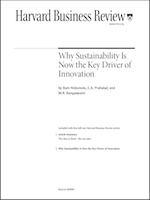"There's no alternative to sustainable development."
 When the Harvard Business Review takes on a subject, you know it has made it to the mainstream! Authors Ram Nidumolu, C.K. Prahalad, and M.R. Rangaswami address innovation and the value of sustainability as a driver in Why Sustainability is Now the Key Driver of Innovation, in the September issue of the Harvard Business Review. Some of the highlights of the article follow.
Most executives treat the need to become sustainable as a corporate social responsibility, divorced from business objectives. [The author's] research shows that sustainability is a mother lode of organizational and technological innovations that yield both bottom-line and top-line returns.
By treating sustainability as a goal today, early movers will develop competencies that rivals will be hard pressed to match.
Enterprises that have started the journey, go through five distinct stages of change.
Stage 1 - Viewing Compliance as Opportunity
When the Harvard Business Review takes on a subject, you know it has made it to the mainstream! Authors Ram Nidumolu, C.K. Prahalad, and M.R. Rangaswami address innovation and the value of sustainability as a driver in Why Sustainability is Now the Key Driver of Innovation, in the September issue of the Harvard Business Review. Some of the highlights of the article follow.
Most executives treat the need to become sustainable as a corporate social responsibility, divorced from business objectives. [The author's] research shows that sustainability is a mother lode of organizational and technological innovations that yield both bottom-line and top-line returns.
By treating sustainability as a goal today, early movers will develop competencies that rivals will be hard pressed to match.
Enterprises that have started the journey, go through five distinct stages of change.
Stage 1 - Viewing Compliance as Opportunity
Using compliance to induce the company and its partners to experiment with sustainable technologies, materials, and processes.
Stage 2 - Making Value Chains SustainableDeveloping sustainable sources of raw materials and components. Increasing the use of clean energy sources such as wind and solar power. Finding innovative uses for returned products.
Stage 3 - Designing Sustainable Products and ServicesApplying techniques such as biomimicry in product development. Developing compact and eco-friendly packaging.
Stage 4 - Developing New Business ModelsDeveloping new delivery technologies that change value-chain relationships in significant ways. Creating monetization models that relate to services rather than products. Devising business models that combine digital and physical infrastructures.
Stage 5 - Creating Next-Practice PlatformsBuilding business platforms that will enable customers and suppliers to manage energy in radically different ways. Developing products that won't need water in categories traditionally associated with it, such as cleaning products. Designing technologies that will allow industries to used the energy produced as a by-product.
A Few Simple Rules- Don't start from the present.
- Ensure that learning precedes investments.
- Stay wedded to the goal while constantly adjusting tactics.
- Build collaborative capacity.
- Use a global presence to experiment.









